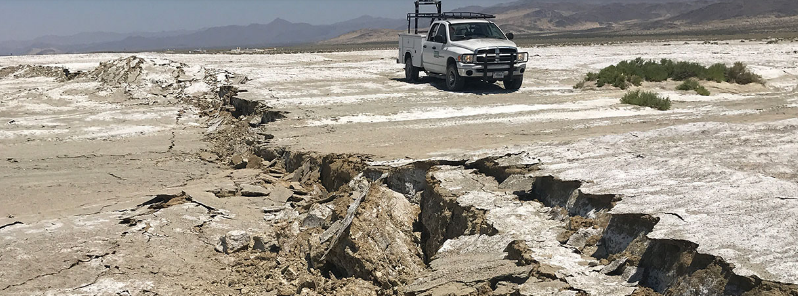Scientists find ‘domino-like’ sequence of ruptures in Ridgecrest Earthquake Sequence, California

A new study of the Ridgecrest Earthquake Sequence, the largest earthquake sequence in Southern California, that began on July 4, 2019, provided new evidence that massive earthquakes can happen in a more complex fashion than commonly expected. The observation by geophysicists from Caltech and NASA's Jet Propulsion Laboratory (JPL) in California reported a series of ruptures in "a web of interconnected faults, with rupturing faults triggering other faults" on October 17, 2019.
According to JPL's study, the domino-like sequence of ruptures also increased strain on a nearby major fault. The Ridgecrest Earthquake Sequence started with a magnitude 6.4, followed by a magnitude 7.1 the next day with over 100 000 aftershocks. The sequence shook most of Southern California, the strongest quake happening about 190 km (120 miles) north of Los Angeles near Ridgecrest.
"This ended up being one of the best-documented earthquake sequences in history," lead author Zachary Ross said, assistant professor of geophysics at Caltech.
Ross developed an automated computer analysis of seismometer data that recorded a massive number of aftershocks with very accurate location data. The JPL team members examined data from international radar satellites ALOS-2 which is from the Japan Aerospace Exploration Agency (JAXA) and Sentinel-1A/B which is operated by the European Space Agency (ESA) to map fault ruptures at the planet's surface.
"I was surprised to see how much complexity there was and the number of faults that ruptured," research co-author Eric Fielding stated.
The data from satellite and seismometer presented an earthquake sequence that is more complex than those in models of previous huge seismic events.
Major earthquakes are typically expected to be triggered by the rupture of a single long fault. After a big earthquake in California in 1992 that ruptured several faults, seismologists started rethinking the model. The Ridgecrest sequence involved about 20 smaller faults previously undiscovered, "crisscrossing in a geometrically complex and geologically young fault zone."
One plausible way for how the Ridgecrest quakes could trigger shaking on the Garlock fault, capable of a magnitude 8 quake, which could then in turn wake up the San Andreas. The chance of this actually happening is slim, but it is plausible. https://t.co/gr7ipDInwy by @gaufre pic.twitter.com/5BJT7YmZRw
— Ron Lin (@ronlin) October 17, 2019
"We actually see that the magnitude 6.4 quake simultaneously broke faults at right angles to each other, which is surprising because standard models of rock friction view this as unlikely," Ross explained.
The event's complexity is clear because of the multiple types of scientific instruments utilized to examine it. Satellites recorded the surface ruptures and correlate ground deformation reaching over 100 km (60 miles) in every path from the rupture, while a dense network of seismometers observed the seismic waves from the earthquake.
Together, the information was used by scientists to create a model of how faults slipped below the surface, the relationship between the major slipping faults, and the number of small quakes occurring before, during, and after the two biggest shocks.
The Ridgecrest ruptures ended near the Garlock Fault, a major east-west fault running more than 300 km (185 miles) from the San Andreas Fault to Death Valley. The fault has been silent for the last 500 years, but the strain on the Garlock Fault by the quake in July caused to gradually start moving. Scientists said the fault has slipped 2 cm (0.8 inches) at the surface since that month.
"It's going to force people to think hard about how we quantify seismic hazard and whether our approach to defining faults needs to change," Ross said. "We can't just assume that the largest faults dominate the seismic hazard if many smaller faults can link up to create these major quakes."
The research was published in the Science journal.
Reference
"Hierarchical interlocked orthogonal faulting in the 2019 Ridgecrest earthquake sequence" – Ross, Z.E. et al – Science – DOI: 10.1126/science.aaz0109
Abstract
A nearly 20-year hiatus in major seismic activity in southern California ended on 4 July 2019 with a sequence of intersecting earthquakes near the city of Ridgecrest, California. This sequence included a foreshock with a moment magnitude (Mw) of 6.4 followed by a Mw 7.1 mainshock nearly 34 hours later. Geodetic, seismic, and seismicity data provided an integrative view of this sequence, which ruptured an unmapped multiscale network of interlaced orthogonal faults. This complex fault geometry persists over the entire seismogenic depth range. The rupture of the mainshock terminated only a few kilometers from the major regional Garlock fault, triggering shallow creep and a substantial earthquake swarm. The repeated occurrence of multifault ruptures, as revealed by modern instrumentation and analysis techniques, poses a formidable challenge in quantifying regional seismic hazards.
Featured image credit: Ben Brooks/USGS

Commenting rules and guidelines
We value the thoughts and opinions of our readers and welcome healthy discussions on our website. In order to maintain a respectful and positive community, we ask that all commenters follow these rules.